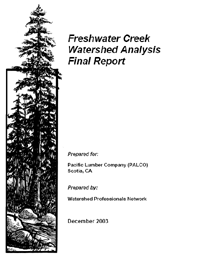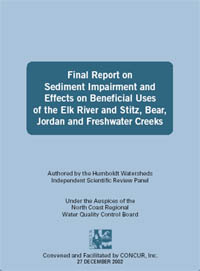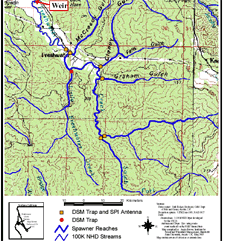 |
 |
Bibliography | Home |
Key Scientific and Wateshed Planning Documents for Humboldt Bay
Several key documents have been completed over the last five years regarding Humboldt Bay watershed management and restoration. The local scientific community and citizen-based monitoring groups have cooperated to advance our knowledge of turbidity and its relationship to land management. A few of these documents are highlighted below. See the Bibliography page for a complete list of documents in KRIS Humboldt Bay.
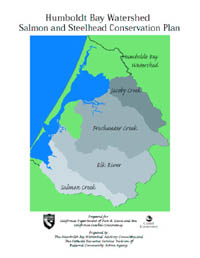 |
Salmon and Steelhead Restoration Plan for Humboldt Bay Humboldt Bay WAC and RCAA Natural Resources Division. 2005. Humboldt Bay Watershed Salmon and Steelhead Conservation Plan. Performed by Humboldt Bay Watershed Advisory Committee and Redwood Community Action Agency Division of Natural Resources. Funded by the California Coastal Conservancy and California Department of Fish and Game. 250 p. (21 Mb) This plan was assembled by the Natural Resources Division of Redwood Community Action Agency in conjunction with the Humboldt Bay Watershed Advisory Committee and is "intended to be used as a framework by agencies and community members either individually or collectively to improve the habitat and management of the Humboldt Bay watershed." The report took several years in preparation as information was acquired, evaluated and analyzed. The report contains a list of high priority goals and objectives aimed at protecting and restoring watershed processes in order to preserve and enhance salmon and steelhead habitat. Funding for the Plan came from the California Department of Fish and Game and the California Coastal Conservancy.
|
|
|
Freshwater Creek Watershed Analysis and ISRP Reports Pacific Lumber Company. 2003. Freshwater Creek Watershed Analysis. Prepared by Watershed Professionals Network for the Pacific Lumber Company (PALCO), Scotia, CA. 899p. (10.4 Mb)
Collison, A., W. Emmingham, F. Everest, W. Hanneberg, R. Martston, D. Tarboton, R. Twiss. 2002. Final Report on Sediment Impairment and Effects on Beneficial Uses of the Elk River and Stitz, Bear, Jordan and Freshwater Creeks. Independent Science Review Panel performed analysis on retainer to the North Coast Regional water Quality Control Board, Santa Rosa, CA. This is the report from the Independent Science Review Panel (ISRP) convened by the North Coast Regional Water Quality Control Board to arbitrate issues of science surrounding management and control of cumulative watershed effects in Humboldt Bay tributaries Elk River and Freshwater Creek as well as lower Eel River tributaries. Collison, A., W. Emmingham, F. Everest, W. Hanneberg, R. Martston, D. Tarboton, R. Twiss. 2003. Phase II Report: Sediment Impairment and Effects on Beneficial Uses of the Elk River and Stitz, Bear, Jordan and Freshwater Creeks. Independent Science Review Panel performed analysis on retainer to the North Coast Regional water Quality Control Board, Santa Rosa, CA. The ISRP was engaged to study more closely effectiveness of the Pacific Lumber Habitat Conservation Plan, Sustained Yield Plan and the California Forest Practice Rules and timber harvest permits (THPs):
|
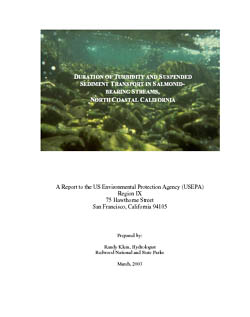 |
Humboldt Bay Sediment and Turbidity Studies and Methods Klein, R. 2003. Duration of turbidity and suspended sediment transport in salmonid-bearing streams, north coastal California. A report to the US Environmental Protection Agency, Region IX. San Francisco, CA. 29 pp. [2.1Mb] This paper compares a wide array of turbidity data from numerous Humboldt County waterhseds, including Humboldt Bay watersheds. The study shows a relationship between watershed conditions and the magnitude and duration of elevated turbidty. Lewis, J. and R. Eads. 1996. Turbidity-controlled suspended sediment sampling. Watershed Management Council Newsletter 6(4): 1&4-5. 4 pp. [34kb] Redwood Sciences Laboratory (RSL) is one of the leading scientific resources on the North Coast. This is an easy to read article from RSL scientists that gives a non-technical overview of turbidity sampling. RSL has many papers and publications on methods and results at their website, as well as much more on how to sample turbidity (http://www.fs.fed.us/psw/rsl/). Salmon Forever. 2001. Volunteer monitoring of suspended sediment concentrations and turbidity in Humboldt, Mendocino and Trinity Counties, California - Quality Assurance Project Plan. Salmon Forever . McKinleyville, CA. 20 pp. [73kb] This Quality Assurance and Quality Control Plan details the strategy for sampling Humboldt Bay tributaries and other North Coast streams by the nonprofit group Salmon Forever.
|
|
California Department of Fish and Game Freshwater Creek Adult and Juvenile Salmon and Steelhead Reports Ricker, S. J. 2005. Results of juvenile salmonid downstream migrant trapping conducted on Freshwater Creek, 2004. [275kb] This report is only one of a series of scientific reports based on field data collected at the Freshwater spawning weir, from down stream migrant traps and adult salmon, carcass and redd surveys. Reports include population estimates for adult coho, chinook and steelhead, tributary production of juveniles, trap efficiencies and length frequency and age of adult and juvenile salmonids. See the KRIS Humboldt Bay Bibliography for access to all CDFG reports.
|
![]()
